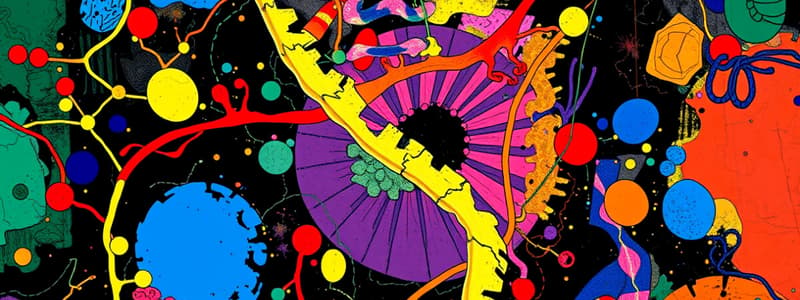Podcast
Questions and Answers
What is the basic property of cells?
What is the basic property of cells?
- Cells are the smallest units that exhibit life. (correct)
- Cells have a nucleus.
- Cells can move on their own.
- Cells do not store DNA.
Prokaryotic cells have a nucleus.
Prokaryotic cells have a nucleus.
False (B)
What type of organisms are prokaryotic cells primarily made up of?
What type of organisms are prokaryotic cells primarily made up of?
Bacteria and cyanobacteria
All cells share certain characteristics; they are all enclosed by a ______.
All cells share certain characteristics; they are all enclosed by a ______.
Which organelle is responsible for energy processing in eukaryotic cells?
Which organelle is responsible for energy processing in eukaryotic cells?
What was the name of the Swiss chemist who first isolated DNA?
What was the name of the Swiss chemist who first isolated DNA?
Which group of cells is generally larger in size?
Which group of cells is generally larger in size?
What do plasmids consist of?
What do plasmids consist of?
Match the following organelles with their primary function:
Match the following organelles with their primary function:
Eukaryotic cells have simpler structures compared to prokaryotic cells.
Eukaryotic cells have simpler structures compared to prokaryotic cells.
In what year did Rosalind Franklin conduct her famous experiment regarding DNA?
In what year did Rosalind Franklin conduct her famous experiment regarding DNA?
Flashcards are hidden until you start studying
Study Notes
DNA and Proteins
-
Cell Theory:
- All organisms are made of one or more cells.
- The cell is the fundamental unit of life.
- Cells arise only through division from preexisting cells.
-
Basics of Cells:
- Cells are the smallest units of life.
- Cells are enclosed by a cell membrane.
- They can reproduce, respond to environmental stimuli, and transform energy.
- DNA is stored in the nucleus, varying by cell type.
Prokaryotic vs Eukaryotic Cells
-
Characteristics:
- Prokaryotic cells lack a nucleus and membrane-bound organelles.
- Eukaryotic cells are more complex, larger (10-100 μm), and can be unicellular or multicellular.
- Both cell types share:
- Membrane enclosure
- DNA as genetic material
- Common metabolic pathways
-
Prokaryotic Cells:
- Size: 1-5 μm, typically unicellular.
- Comprise bacteria and cyanobacteria.
- Enclosed by plasma membrane and a rigid cell wall.
- Have a single loop of double-stranded DNA with plasmids.
- Include short projections (pili) and longer projections (flagella) aiding movement.
-
Eukaryotic Cells:
- More organized with specialized functions.
- Comprised of various organelles with distinct roles ranging from chemical manufacture to energy processing.
Organelles and Their Functions
-
Manufacture of Chemicals:
- Organelles like the nucleus, ribosomes, and Golgi apparatus produce nucleic acids and proteins.
-
Breakdown of Materials:
- Lysosomes and vacuoles are responsible for the breakdown of materials, including foreign substances.
-
Energy Processing:
- Mitochondria and chloroplasts are involved in respiration and photosynthesis, respectively.
-
Support and Communication:
- Structures like the cytoskeleton, cell walls, and membrane surfaces support cell movement and communication.
Evolution of Organelles
- Some organelles, specifically mitochondria and chloroplasts, contain their own DNA, which is double-stranded and circular.
- A theory suggests they evolved from prokaryotic ancestors.
Structure and Function of DNA
- DNA contains the genetic code.
- It replicates to pass genetic information.
- Provides instructions for protein synthesis, crucial for building organisms and catalyzing biochemical reactions.
History of DNA Discovery
- Friedrich Miescher (1869):
- Isolated nuclein from pus cells, rich in phosphorus; later known as nucleic acid.
- Rosalind Franklin (1952):
- Contributed to understanding DNA structure through X-ray diffraction.
- Watson and Crick:
- Proposed the double helix structure of DNA, further defining its role as genetic material.
Studying That Suits You
Use AI to generate personalized quizzes and flashcards to suit your learning preferences.




